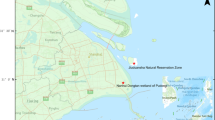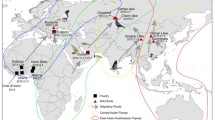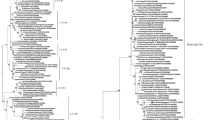Abstract
The first detection of a human infection with avian influenza A/H6N1 virus in Taiwan in 2013 has raised concerns about this virus. During our routine surveillance of avian influenza viruses (AIVs) in live-bird markets in Egypt, an H6N1 virus was isolated from a garganey duck and was characterized. Phylogenetic analysis indicated that the Egyptian H6N1 strain A/Garganey/Egypt/20869C/2022(H6N1) has a unique genomic constellation, with gene segments inherited from different subtypes (H5N1, H3N8, H7N3, H6N1, and H10N1) that have been detected previously in AIVs from Egypt and some Eurasian countries. We examined the replication of kinetics of this virus in different mammalian cell lines (A549, MDCK, and Vero cells) and compared its pathogenicity to that of the ancestral H6N1 virus A/Quail/HK/421/2002(H6N1). The Egyptian H6N1 virus replicated efficiently in C57BL/6 mice without prior adaptation and grew faster and reached higher titers than in A549 cells than the ancestral strain. These results show that reassortant H6 AIVs might pose a potential threat to human health and highlight the need to continue surveillance of H6 AIVs circulating in nature.








Similar content being viewed by others
Data availability
Sequence data from this study are publicly available in the GenBank database under the accession numbers listed in Supplementary Table S1. All other data are available upon request.
References
Abed Y, Goyette N, Boivin G (2005) Generation and characterization of recombinant influenza A (H1N1) viruses harboring amantadine resistance mutations. Antimicrob Agents Chemother 49:556–559
Bean WJ, Threlkeld SC, Webster RG (1989) Biologic potential of amantadine-resistant influenza A virus in an avian model. J Infect Dis 159:1050–1056
Cheung CL, Rayner JM, Smith GJ, Wang P, Naipospos TS, Zhang J, Yuen KY, Webster RG, Peiris JS, Guan Y, Chen H (2006) Distribution of amantadine-resistant H5N1 avian influenza variants in Asia. J Infect Dis 193:1626–1629
Chutinimitkul S, van Riel D, Munster VJ, van den Brand JM, Rimmelzwaan GF, Kuiken T, Osterhaus AD, Fouchier RA, de Wit E (2010) In vitro assessment of attachment pattern and replication efficiency of H5N1 influenza A viruses with altered receptor specificity. J Virol 84:6825–6833
Conenello GM, Zamarin D, Perrone LA, Tumpey T, Palese P (2007) A single mutation in the PB1-F2 of H5N1 (HK/97) and 1918 influenza A viruses contributes to increased virulence. PLoS Pathog 3:1414–1421
Downie JC, Laver WG (1973) Isolation of a type A influenza virus from an Australian pelagic bird. Virology 51:259–269
El-Shesheny R, Kandeil A, Mostafa A, Ali MA, Webby RJ (2021) H5 Influenza Viruses in Egypt. Cold Spring Harb Perspect Med 11
El-Shesheny R, Moatasim Y, Mahmoud SH, Song Y, El Taweel A, Gomaa M, Kamel MN, Sayes ME, Kandeil A, Lam TTY, McKenzie PP, Webby RJ, Kayali G, Ali MA (2022) Highly Pathogenic Avian Influenza A(H5N1) Virus Clade 2.3.4.4b in Wild Birds and Live Bird Markets, Egypt. Pathogens 12
Gao Y, Zhang Y, Shinya K, Deng G, Jiang Y, Li Z, Guan Y, Tian G, Li Y, Shi J, Liu L, Zeng X, Bu Z, Xia X, Kawaoka Y, Chen H (2009) Identification of amino acids in HA and PB2 critical for the transmission of H5N1 avian influenza viruses in a mammalian host. PLoS Pathog 5:e1000709
Gillim-Ross L, Santos C, Chen Z, Aspelund A, Yang CF, Ye D, Jin H, Kemble G, Subbarao K (2008) Avian influenza h6 viruses productively infect and cause illness in mice and ferrets. J Virol 82:10854–10863
Hu C, Li X, Zhu C, Zhou F, Tang W, Wu D, Li Z, Zhou L, Liu J, Wei X, Cui J, Wang T, He G (2020) Co-circulation of multiple reassortant H6 subtype avian influenza viruses in wild birds in eastern China, 2016–2017. Virol J 17:62
Hulse-Post DJ, Franks J, Boyd K, Salomon R, Hoffmann E, Yen HL, Webby RJ, Walker D, Nguyen TD, Webster RG (2007) Molecular changes in the polymerase genes (PA and PB1) associated with high pathogenicity of H5N1 influenza virus in mallard ducks. J Virol 81:8515–8524
Ilyushina NA, Seiler JP, Rehg JE, Webster RG, Govorkova EA (2010) Effect of neuraminidase inhibitor-resistant mutations on pathogenicity of clade 2.2 A/Turkey/15/06 (H5N1) influenza virus in ferrets. PLoS Pathog 6:e1000933
Jiao P, Tian G, Li Y, Deng G, Jiang Y, Liu C, Liu W, Bu Z, Kawaoka Y, Chen H (2008) A single-amino-acid substitution in the NS1 protein changes the pathogenicity of H5N1 avian influenza viruses in mice. J Virol 82:1146–1154
Kandeil A, Moatasim Y, El Taweel A, El Sayes M, Rubrum A, Jeevan T, McKenzie PP, Webby RJ, Ali MA, Kayali G, El-Shesheny R (2022) Genetic and Antigenic Characteristics of Highly Pathogenic Avian Influenza A(H5N8) Viruses Circulating in Domestic Poultry in Egypt, 2017–2021. Microorganisms 10
Kandeil A, Kayed A, Moatasim Y, Aboulhoda BE, El Taweel AN, Kutkat O, El Sayes M, Gomaa M, El-Shesheny R, Webby R, Kayali G, Ali MA (2023) Molecular identification and virological characteristics of highly pathogenic avian influenza A/H5N5 virus in wild birds in Egypt. Microb Pathog 174:105928
Kayali G, Kandeil A, El-Shesheny R, Kayed AS, Maatouq AM, Cai Z, McKenzie PP, Webby RJ, El Refaey S, Kandeel A, Ali MA (2016) Avian Influenza A(H5N1) Virus in Egypt. Emerg Infect Dis 22:379–388
Kayed AE, Kutkat O, Kandeil A, Moatasim Y, El Taweel A, El Sayes M, El-Shesheny R, Aboulhoda BE, Abdeltawab NF, Kayali G, Ali MA, Ramadan MA (2023) Comparative pathogenic potential of avian influenza H7N3 viruses isolated from wild birds in Egypt and their sensitivity to commercial antiviral drugs. Arch Virol 168
Kayed AS, Kandeil A, Gomaa MR, El-Shesheny R, Mahmoud S, Hegazi N, Fayez M, Sheta B, McKenzie PP, Webby RJ, Kayali G, Ali MA (2019) Surveillance for avian influenza viruses in wild birds at live bird markets, Egypt, 2014–2016. Influenza Other Respir Viruses 13:407–414
Krauss S, Obert CA, Franks J, Walker D, Jones K, Seiler P, Niles L, Pryor SP, Obenauer JC, Naeve CW, Widjaja L, Webby RJ, Webster RG (2007) Influenza in migratory birds and evidence of limited intercontinental virus exchange. PLoS Pathog 3:e167
Kumar S, Stecher G, Tamura K (2016) MEGA7: Molecular Evolutionary Genetics Analysis Version 7.0 for Bigger Datasets. Mol Biol Evol 33:1870–1874
Leneva IA, Goloubeva O, Fenton RJ, Tisdale M, Webster RG (2001) Efficacy of zanamivir against avian influenza A viruses that possess genes encoding H5N1 internal proteins and are pathogenic in mammals. Antimicrob Agents Chemother 45:1216–1224
Li Z, Jiang Y, Jiao P, Wang A, Zhao F, Tian G, Wang X, Yu K, Bu Z, Chen H (2006) The NS1 gene contributes to the virulence of H5N1 avian influenza viruses. J Virol 80:11115–11123
Lin W, Cui H, Teng Q, Li L, Shi Y, Li X, Yang J, Liu Q, Deng J, Li Z (2020) Evolution and pathogenicity of H6 avian influenza viruses isolated from Southern China during 2011 to 2017 in mice and chickens. Sci Rep 10:20583
Maines TR, Chen LM, Van Hoeven N, Tumpey TM, Blixt O, Belser JA, Gustin KM, Pearce MB, Pappas C, Stevens J, Cox NJ, Paulson JC, Raman R, Sasisekharan R, Katz JM, Donis RO (2011) Effect of receptor binding domain mutations on receptor binding and transmissibility of avian influenza H5N1 viruses. Virology 413:139–147
Mercan Y, Atim G, Kayed AE, Azbazdar ME, Kandeil A, Ali MA, Rubrum A, McKenzie P, Webby RJ, Erima B, Wabwire-Mangen F, Ukuli QA, Tugume T, Byarugaba DK, Kayali G, Ducatez MF, Koçer ZA (2021) Molecular Characterization of Closely Related H6N2 Avian Influenza Viruses Isolated from Turkey, Egypt, and Uganda. Viruses 13
Moatasim Y, Kandeil A, Aboulhoda BE, El-Shesheny R, Alkhazindar M, AbdElSalam ET, Kutkat O, Kamel MN, El Taweel AN, Mostafa A, Hicks JT, Abd Elghaffar SK, Kayali G, Ali MA (2019) Comparative Virological and Pathogenic Characteristics of Avian Influenza H5N8 Viruses Detected in Wild Birds and Domestic Poultry in Egypt during the Winter of 2016/2017. Viruses 11
Munier S, Larcher T, Cormier-Aline F, Soubieux D, Su B, Guigand L, Labrosse B, Cherel Y, Quéré P, Marc D, Naffakh N (2010) A genetically engineered waterfowl influenza virus with a deletion in the stalk of the neuraminidase has increased virulence for chickens. J Virol 84:940–952
REED LJ, MUENCH H (1938) A SIMPLE METHOD OF ESTIMATING FIFTY PER CENT ENDPOINTS12. Am J Epidemiol 27:493–497
Saad MD, Ahmed LS, Gamal-Eldein MA, Fouda MK, Khalil F, Yingst SL, Parker MA, Montevillel MR (2007) Possible avian influenza (H5N1) from migratory bird, Egypt. Emerg Infect Dis 13:1120–1121
Salaheldin AH, Elbestawy AR, Abdelkader AM, Sultan HA, Ibrahim AA, Abd El-Hamid HS, Abdelwhab EM (2022) Isolation of Genetically Diverse H5N8 Avian Influenza Viruses in Poultry in Egypt, 2019–2021. Viruses 14
Schmolke M, Manicassamy B, Pena L, Sutton T, Hai R, Varga ZT, Hale BG, Steel J, Perez DR, Garcia-Sastre A (2011) Differential contribution of PB1-F2 to the virulence of highly pathogenic H5N1 influenza A virus in mammalian and avian species. PLoS Pathog 7:e1002186
Seo SH, Hoffmann E, Webster RG (2002) Lethal H5N1 influenza viruses escape host anti-viral cytokine responses. Nat Med 8:950–954
Sleeman K, Guo Z, Barnes J, Shaw M, Stevens J, Gubareva LV (2013) R292K substitution and drug susceptibility of influenza A(H7N9) viruses. Emerg Infect Dis 19:1521–1524
Subbarao EK, London W, Murphy BR (1993) A single amino acid in the PB2 gene of influenza A virus is a determinant of host range. J Virol 67:1761–1764
Sun H, Kaplan BS, Guan M, Zhang G, Ye J, Long LP, Blackmon S, Yang CK, Chiang MJ, Xie H, Zhao N, Cooley J, Smith DF, Liao M, Cardona C, Li L, Wang GP, Webby R, Wan XF (2017) Pathogenicity and transmission of a swine influenza A(H6N6) virus. Emerg microbes infections 6:e17
Wan H, Perez DR (2007) Amino acid 226 in the hemagglutinin of H9N2 influenza viruses determines cell tropism and replication in human airway epithelial cells. J Virol 81:5181–5191
Wang G, Deng G, Shi J, Luo W, Zhang G, Zhang Q, Liu L, Jiang Y, Li C, Sriwilaijaroen N, Hiramatsu H, Suzuki Y, Kawaoka Y, Chen H (2014) H6 influenza viruses pose a potential threat to human health. J Virol 88:3953–3964
Webster RG, Bean WJ, Gorman OT, Chambers TM, Kawaoka Y (1992) Evolution and ecology of influenza A viruses. Microbiol Rev 56:152–179
Wei SH, Yang JR, Wu HS, Chang MC, Lin JS, Lin CY, Liu YL, Lo YC, Yang CH, Chuang JH, Lin MC, Chung WC, Liao CH, Lee MS, Huang WT, Chen PJ, Liu MT, Chang FY (2013) Human infection with avian influenza A H6N1 virus: an epidemiological analysis. Lancet Respir Med 1:771–778
Wu H, Yang F, Liu F, Lu R, Peng X, Chen B, Yao H, Wu N (2018) Isolation and characterization of novel reassortant H6N1 avian influenza viruses from chickens in Eastern China. Virol J 15:164
Yamayoshi S, Yamada S, Fukuyama S, Murakami S, Zhao D, Uraki R, Watanabe T, Tomita Y, Macken C, Neumann G, Kawaoka Y (2014) Virulence-affecting amino acid changes in the PA protein of H7N9 influenza A viruses. J Virol 88:3127–3134
Yuan J, Zhang L, Kan X, Jiang L, Yang J, Guo Z, Ren Q (2013) Origin and molecular characteristics of a novel 2013 avian influenza A(H6N1) virus causing human infection in Taiwan. Clin Infect Dis 57:1367–1368
Zhang G, Kong W, Qi W, Long LP, Cao Z, Huang L, Qi H, Cao N, Wang W, Zhao F, Ning Z, Liao M, Wan XF (2011) Identification of an H6N6 swine influenza virus in southern China. Infect Genet evolution: J Mol Epidemiol evolutionary Genet Infect Dis 11:1174–1177
Zhao G, Chen C, Huang J, Wang Y, Peng D, Liu X (2013) Characterisation of one H6N6 influenza virus isolated from swine in China. Res Vet Sci 95:434–436
Zhong W, Gao L, Wang X, Su S, Lin Y, Huang K, Zhou S, Fan X, Zhang Z (2022) Influenza A (H6N6) viruses isolated from chickens replicate in mice and human lungs without prior adaptation. J Virus Erad 8:100086
Acknowledgments
The authors would like to acknowledge Rebecca Badra and Mona Mahmoud for editing the manuscript.
Funding
This research was funded by the National Institute of Allergy and Infectious Diseases, National Institutes of Health, US Department of Health and Human Services (under contract 5N93021C00016).
Author information
Authors and Affiliations
Contributions
Conceptualization: A.K., P.P.M., R.J.W., M.A.A., G.K., and R.E. Methodology: AK and RE. Formal analysis: A.K. and R.E. Investigation: O.K., M.G., B.E.A., Y.M., A.E.T., M.N.K., M.E.S., A.E., H.A., and B.E.A. Writing—original draft preparation: A.K. and R.E. Writing—review and editing: G.K. and R.E. Supervision: A.K., M.A.A., G.K., and R.E. Project administration: R.E. Funding acquisition: R.J.W., M.A.A., and G.K. All authors have read and agreed to the published version of the manuscript.
Corresponding authors
Ethics declarations
Ethical approval
This study was approved by the Research Ethics Committee of the National Research Centre (Egypt) (protocol number 14 155).
Conflict of interest
The authors declare no conflict of interest. The funders had no role in the design of the study; in the collection, analysis, or interpretation of data; in the writing of the manuscript; or in the decision to publish the results.
Additional information
Communicated by Ayato Takada
Publisher’s Note
Springer Nature remains neutral with regard to jurisdictional claims in published maps and institutional affiliations.
Electronic Supplementary Material
Below is the link to the electronic supplementary material
Rights and permissions
Springer Nature or its licensor (e.g. a society or other partner) holds exclusive rights to this article under a publishing agreement with the author(s) or other rightsholder(s); author self-archiving of the accepted manuscript version of this article is solely governed by the terms of such publishing agreement and applicable law.
About this article
Cite this article
Kutkat, O., Gomaa, M., Aboulhoda, B.E. et al. Genetic and virological characteristics of a reassortant avian influenza A H6N1 virus isolated from wild birds at a live-bird market in Egypt. Arch Virol 169, 95 (2024). https://doi.org/10.1007/s00705-024-06022-6
Received:
Accepted:
Published:
DOI: https://doi.org/10.1007/s00705-024-06022-6




